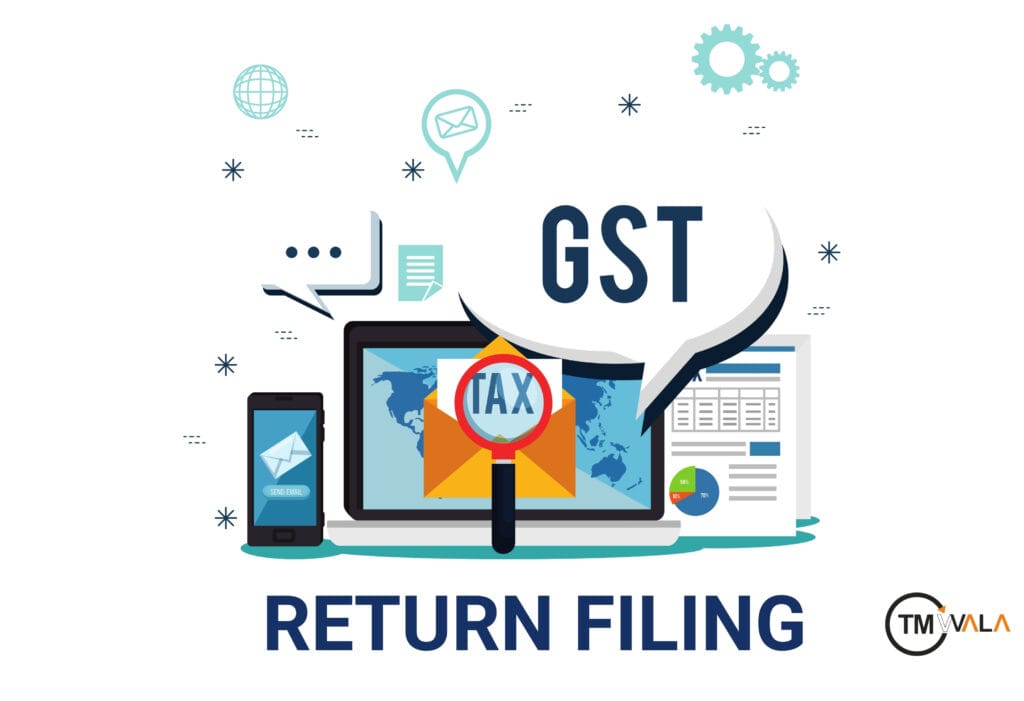Overview
GST return filing contain the complete information related to every sales & income and purchase & expenses made by registered GST taxpayer that can be identified from their (GSTIN) tax number. This document is sent to the tax administration authorities, which make it possible for us to determine how much taxpayers owe or are owed.
Elements of a GST return
In GST, a registered dealer in any tax period has to file returns generally containing following details: –
- Acquisitions: Purchases of products and services.
- Sales – All goods and services sold.
- GST Output: Sales tax collected.
- Input Tax Credit: The GST at the time of purchase which is deducted from output GST
Once GST returns are filed, the taxpayer must pay any resulting tax liability, which is the amount owed to the government after adjusting input tax credit against output GST.
Filing Frequency
GST returns must be filed periodically, with the frequency depending on the category of the taxpayer and the specifics of their business. The possible filing frequencies are: monthly, quarterly, and annually.
Importance of GST Return Filing
It is crucial to file your GST returns to follow the tax regulations and let you have a clear financial picture. It accurately records sales, purchases, output GST, and input tax credits, helping tax authorities calculate the net tax liability. Anyone dealing with production and storage along the distribution would benefit from the timely and accurate filing of GST Returns to avoid penalties/legal hassles and help in credit flow from input tax point properly so that can facilitate refund claims more effectively. It also encourages your accountability and credibility, thereby strengthening the business’s reputation in front of stakeholders or financial institutions. Eventually, GST return filing is necessary to commit to statutory responsibility and smooth working of any business operation.
Taxpayers Categorization
There are 7 categories of GST taxpayers, each with different requirements for filing GST returns:
- Regular Taxpayer: Standard businesses that do not fall into any of the special categories.
- Composition Taxable Persons: Small taxpayers who pay GST at a fixed rate on turnover and are exempt from detailed record-keeping.
- Input Service Distributors: Businesses that distribute the input tax credit to their branches.
- Casual Taxable Persons: Individuals or businesses that occasionally supply goods or services in a taxable territory where they do not have a fixed place of business.
- TDS Deductors: Entities required to deduct tax at source.
- Non-resident Taxpayers: Foreign businesses operating in India without a permanent establishment.
- E-commerce Operators: Online platforms that facilitate the supply of goods and services.
Eligibility Criteria for GST Return Filing
GST returns are to be filed by all businesses and individuals registered under the GST regime. This requirement applies to entities whose annual aggregate turnover exceeds the specified threshold, which varies based on the taxpayer category, including regular businesses, those under the Composition Scheme, and other classifications.
Under GST regulations:
- Regular Businesses: Entities with an annual aggregate turnover exceeding Rs. 5 crore (excluding those under the QRMP scheme) must file two monthly returns and an annual return, totaling 25 returns annually.
- QRMP Scheme: Taxpayers with turnover up to Rs. 5 crore can opt for the Quarterly Return Monthly Payment (QRMP) scheme, involving nine returns per year—4 GSTR-1 and GSTR-3B each, along with an annual return. The scheme allows for quarterly filing, but it requires a monthly payment of taxes through challan.
- Composition Dealers: These taxpayers file five returns annually—4 statement-cum-challans in CMP-08 and one annual return GSTR-4.
Types of GST Returns and related details
There are approximately 22 types of GST forms available. Among these, 11 forms are currently active, 8 are view-only, and 3 have been suspended. The specific forms a taxpayer must file depend on their registration type and business activities.
| GST Returns | Description | Frequency | Due Date |
| GSTR-1 | Details of outward supplies of taxable goods and/or services affected. | Monthly | 11th of the next month. |
| Quarterly for those under QRMP scheme | 13th day of the month after the quarter | ||
| IFF (Optional by taxpayers under the QRMP scheme) | Details of B2B supplies of taxable goods and/or services affected. | Monthly (for the first two months of the quarter) | 13th of the next month. |
| GSTR-2(Suspended) | Monthly return form used to give the details of inward supply or purchases | 15th of next month of the tax period | |
| GSTR-3B | Summary return of outward supplies and input tax credit claimed, along with payment of tax by the taxpayer. | Monthly | 20th of the next month. |
| Quarterly (For taxpayers under the QRMP scheme) | 22nd or 24th of the month succeeding the quarter | ||
| GSTR-9 | Annual return by a regular taxpayer. | Annually | 31st December of the next financial year. |
| GSTR-9C | GST audit form for taxpayers with turnover exceeding Rs. 2 crores annually. | Annually | 31st December of the year subsequent |
| Businesses registered under the Composition Scheme | |||
| GSTR-4 | It is for Composition Scheme taxpayers. It applies to businesses with goods turnover up to Rs. 1.5 crores and service providers up to Rs. 50 lakhs, allowing them to pay tax at a predetermined rate. | Annually | 30th April of the next financial year |
| GSTR-9A | GSTR-4 replaces quarterly submissions; taxpayers now file CMP-08 challans quarterly by the 18th. | ||
| CMP-08 | Statement-cum-challan to make a tax payment by a taxpayer registered under the composition scheme under Section 10 of the CGST Act. | Quarterly | 18th of the month succeeding the quarter. |
| Other types of business owners and dealers | |||
| GSTR-5 | Mandated for non-resident foreign taxpayers conducting business in India, records their outbound and inbound transactions, adjustments, tax liabilities, and payments, submitted accordingly. | Monthly | For registrations less than 1 month, due within 7 days of expiry. For longer, due on the 20th or within 7 days of expiry. |
| GSTR-5A | It is a monthly summary for OIDAR service providers, due by the 20th. | Monthly | 20th of the next month. |
| GSTR-6 | Input Service Distributors are required to file GSTR-6, detailing the ITC received and allocated, with comprehensive documentation on credit distribution. | Monthly | 13th of the following month of the tax period |
| GSTR-7 | Entities required to deduct TDS under GST must file GSTR-7, detailing deducted TDS, amounts due and paid, and any refunds. | Monthly | 10th of the next month |
| GSTR-8 | This form is mandatory for GST-registered e-commerce operators who collect tax at source. It documents all supplies made via the platform along with the corresponding TCS details. | Monthly | 10th of the following month. |
| GSTR-9B | It is filed by e-commerce operators mandated to deduct Tax Collection at Source (TCS) under Section 52 of the CGST Act, 2017. It applies to operators facilitating sales where sellers differ. | Annually | |
| GSTR-10 | The last return required from a taxpayer after their GST registration has been cancelled. | Once, when the GST registration is cancelled or surrendered. | Date of order of cancellation, or within 3 months from the date of cancellation, whichever is later. |
| GSTR-11 | A fluctuating tax return for taxpayers with UINs, detailing purchases by foreign embassies and diplomatic missions for self-use within a specific month. | 28th of the following month in which the UIN holders receive the inward supply | |
| ITC-04 | A statement required from a principal or job-worker detailing goods sent to or received from a job-worker. | Yearly (for Annual Aggregate Turnover up to Rs. 5 crore) Bi-annually (for Annual Aggregate Turnover exceeding Rs. 5 crore) | 25th April where AATO is up to Rs.5 crore. 25th October and 25th April where AATO exceeds Rs.5 crore. |
| Auto-drafted Returns | |||
| GSTR-2A | GSTR-2A is a dynamic, read-only return for purchasers, auto-filled with suppliers’ GSTR-1 and IFF data. | ||
| GSTR-2B | Introduced in August 2020, GSTR-2B is a static, read-only return providing ITC information from the previous month’s GSTR-1 filings, aiding purchasers in ITC claims. | ||
| GSTR-4A | Quarterly tax return for composition dealers, auto-generated from supplier GSTR-1, GSTR-5, and GSTR-7 data. | ||
| Tax Notice | |||
| GSTR-3A | A tax notice issued by the tax authority to a defaulter who has not timely filed monthly GST returns. | ||
Guide for online GST return filing
- Step 1: To register on the GST Portal, visit the GST official website, www.gst.gov.in, click on ‘Register Now,’ and fill in the required details including name, PAN number, email ID, and mobile number.
- Step 2: Login to the GST Portal after registering yourself, using your username and password. Navigate to the dashboard where options like Returns and Payments are available.
- Step 3: Choose the appropriate return form based on your turnover and eligibility. For instance, for turnover below Rs. 1.5 crores, file GSTR-1 (monthly or quarterly), GSTR-3B (monthly), and GSTR-4 (annual), etc.
- Step 4: Fill in the details in the Return Form like invoice, tax, and payment details manually or you could use an excel sheet to upload them.
- Step 5: Verify the entered details against your financial records (invoices, receipts).
- Step 6: Preview for any errors. Submit the Return Form to receive an acknowledgement with a unique reference number (ARN). You need to ensure the status of the GST return has been changed to ‘Submitted’.
- Step 7: Pay the Tax Due. Use online payment options (net banking, credit/debit card, NEFT/RTGS) to pay any taxes owed.
- Step 8: Even if no transactions occurred, file a nil return by selecting the form and choosing ‘Nil Return,’ entering ‘0’ in all fields.
These steps ensure accurate and compliant GST return filing through the GST portal.
Consequences for not filing GST Return
If GST returns are not filed within the specified deadlines, you will incur interest and late fees.
Interest is levied at 18% per annum on the outstanding tax amount, calculated from the day following the due date of filing until the date of payment.
Late fees amount to Rs. 100 per day per Act, totaling Rs. 200 per day (Rs. 100 under CGST and Rs. 100 under SGST), with a maximum cap of Rs. 5,000. For annual returns like GSTR-9 and GSTR-9C, the late fee is capped at 0.25% of turnover in your state or UT, unless revised by government regulations.
Conclusion
Navigating the GST return filing process is crucial for businesses to maintain compliance and transparency in their tax obligations. By following these steps on the GST portal, businesses can ensure accurate reporting of their financial activities, timely payment of taxes, and seamless reconciliation of records. This not only fulfils legal requirements but also supports the smooth operation and growth of businesses in the dynamic economic landscape governed by GST regulations. Taking these steps diligently not only safeguards against penalties but also builds trust with stakeholders and contributes to the broader goals of financial accountability and regulatory adherence.
Frequently Asked Questions (FAQs)
- What is GST Return Filing?
GST Return Filing involves reporting details of sales, purchases, and taxes to the tax authorities. It ensures compliance with GST laws.
- Who needs to file GST Returns?
All businesses and individuals registered under GST, whose turnover exceeds the threshold limit, must file GST Returns.
- What are the types of GST Returns?
Types include GSTR-1 (outward supplies), GSTR-3B (summary return), GSTR-4 (composition scheme), and others depending on business activities.
- When are GST Returns due?
Due dates vary based on the type of taxpayer and turnover. Generally, GSTR-3B is due by the 20th of the following month, and GSTR-1 by the 10th of the next month.
- How can I file GST Returns online?
Register on the GST portal, log in, navigate to ‘Returns,’ select the appropriate form, fill in details, verify, and submit. Pay any taxes due online.
- What happens if I miss the GST Return filing deadline?
Late filing attracts penalties of Rs. 50 per day (Rs. 20 for NIL returns). Late payment incurs interest on the outstanding tax amount.
- Can I revise GST Returns after filing?
Yes, you can revise GSTR-1 and GSTR-3B for errors or omissions in subsequent periods. GSTR-4 and annual returns cannot be revised.
- What should I do if I have not made any sales or purchases in a period?
File a NIL return by entering ‘0’ in all relevant fields of the applicable GST return form to comply with filing requirements.
- How can I track the status of my filed GST Returns?
Check the GST portal dashboard for status updates. A ‘Submitted’ status indicates successful filing.
- What documents do I need for GST Return Filing?
Gather invoices, receipts, and records of purchases and sales. Maintain accurate financial records for reconciliation and audit purposes.
- Can I claim Input Tax Credit (ITC) through GST Returns?
Yes, you can claim ITC on GST paid on purchases. Ensure the suppliers have filed their GST returns and correctly reported sales.
- What are the consequences of non-compliance with GST Return Filing?
Non-compliance can lead to penalties, interest on unpaid taxes, and legal repercussions. It may also affect business reputation and ability to operate smoothly.
- Are there any exemptions from filing GST Returns?
Some small businesses and specific categories like Input Service Distributors (ISD) may have simplified filing requirements. Consult with a tax professional for exemptions.
- How can I rectify errors in my GST Returns?
Rectify errors by filing subsequent returns with correct information. Consult with a tax expert if errors require adjustments or amendments.
- Where can I get help or support for GST Return Filing?
For assistance, visit the GST portal’s help section, contact GST helpdesk numbers, or seek guidance from a qualified tax consultant or Chartered Accountant (CA).















